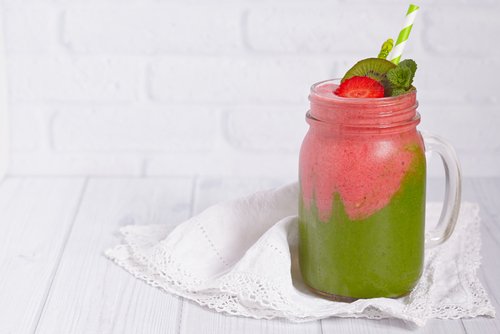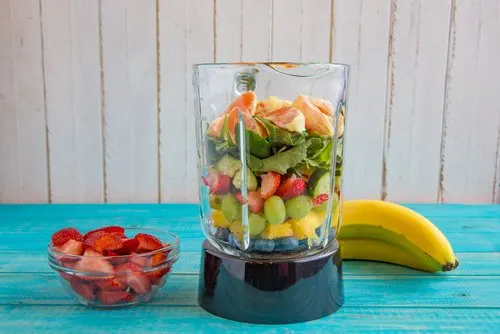A Smoothie that May Help Fight Alopecia

As the seasons change, many men and women suffer from temporary alopecia, which in some cases can be distressing. However, there are natural ways that may help fight alopecia. They provide our body all the nutrients it needs so our hair doesn’t suffer.
In this article, we will show you how to make a delicious and healthy smoothie that may help you fight alopecia.
Help fight alopecia with your diet

Alopecia can have different causes, such as endocrine disorders and nutritional deficiencies. These are the two main causes we’re going to focus on.
Both hormonal disorders and vitamin and mineral deficiencies can cause hair loss that can be reversible if you consume the right foods.
Read more here: How To Treat Alopecia Naturally
In this article, we’ve selected some foods which have medicinal properties that will give us what our body needs without having to take medication or supplements.
Smoothies are a simple and convenient way to consume several of these foods at the same time. Therefore, we suggest consuming a smoothie every day that may help you reduce your risk of or help fight alopecia and get healthy hair.
How to prepare the smoothie
Here are several ingredients that can be part of the smoothie that may help fight alopecia:
Spinach
All green leafy vegetables, including spinach, may be very beneficial for hair health since they provide us with vitamins A and C, which are related to hair’s natural hydration.
In addition, leafy vegetables also provide our body with iron as they contain abundant quantities of the nutrient. This is important because iron deficiencies may lead to alopecia.
Strawberries
Strawberries are rich in folic acid, vitamins B6 and B7, and silicon, an essential mineral for hair.
These nutrients may help us get smooth and shiny hair, while helping to fight dandruff and other scalp problems.
Oats
All whole grains are essential for good health and for beautiful hair. Oats contain B vitamins, which may stimulate hair growth and reduce your risk of alopecia while promoting thicker, stronger hair.
Oranges

Walnuts
Nuts are rich in minerals, which are essential for good hair health. Walnuts may be a very healthy remedy for fine and brittle hair because they give it enough elasticity so that it doesn’t break. Thus, it may be a great way to fight alopecia.
Flax oil
The oil extracted from flaxseed is rich in essential fatty acids, which may stimulate growth from the hair follicle and help us have hydrated hair. It’s an essential ingredient if we have dry hair or damaged ends.
Brewer’s yeast
Brewer’s yeast is an ideal hair, skin, and nail supplement and many people take it because it may reduce their chances of alopecia thanks to its high vitamin and mineral content.
Maca
This root vegetable, originally from Peru, is also a very beneficial food for our hair, as it gives us a lot of vitamins and minerals, especially iron.
Discover: 7 Hair Loss Myths
In addition, it may be an excellent hormonal regulator for both men and women, but without the side effects.
The amounts you’ll need to make the smoothie
You’ll need the following amounts to prepare the smoothie:
- A handful of tender spinach
- 5 ripe strawberries (organic, if possible)
- A tablespoonful of oat flakes (10 g)
- One glass of freshly squeezed orange juice (200 ml)
- One tablespoon of flax oil (15 g)
- 4 raw and unsalted nuts
- One tablespoon of brewer’s yeast (10 g)
- One teaspoon of maca powder (5 g)
How to prepare it
- First, squeeze the juice from the orange.
- Blend the orange juice along with the rest of the ingredients for at least 1 minute, until you get a creamy, lump-free texture.
It’s best to consume this smoothie every morning on an empty stomach. We recommend that you always prepare it just before you consume it so all its beneficial nutrients can be preserved.
All cited sources were thoroughly reviewed by our team to ensure their quality, reliability, currency, and validity. The bibliography of this article was considered reliable and of academic or scientific accuracy.
- Messenger, A. (2008). Male androgenetic alopecia. In Hair, Hair Growth and Hair Disorders. https://doi.org/10.1007/978-3-540-46911-7_9
- Trüeb, R. M. (2015). Androgenetic alopecia. In European Handbook of Dermatological Treatments, Third Edition. https://doi.org/10.1007/978-3-662-45139-7_5
- Jabbari, A., Petukhova, L., & Christiano, A. M. (2017). Alopecia areata. In Clinical and Basic Immunodermatology: Second Edition. https://doi.org/10.1007/978-3-319-29785-9_29
- Falto-Aizpurua, L., Choudhary, S., & Tosti, A. (2014). Emerging treatments in alopecia. Expert Opinion on Emerging Drugs. https://doi.org/10.1517/14728214.2014.974550
This text is provided for informational purposes only and does not replace consultation with a professional. If in doubt, consult your specialist.








